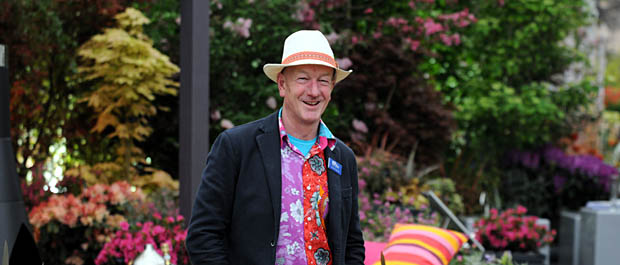
Hampshire horticulturalists have struck gold at the 100th RHS Chelsea Flower Show.
In the Great Pavillion, Hillier Nurseries Ltd scooped their 68th gold with the largest exhibit – ‘Risk’ – and Hardy’s Cottage Garden Plants won their 18th gold medal.
Hillier designer Andy McIndoe created a series of garden scenes on an exhibit packed with risky plant, colour and foliage combinations and colossal British-grown trees that skim the roof of the Great Pavillion. Features extraordinary sculpture by Mehrdad Tafreshi and Tom Stogdon, sensational pathways by Organicstone and fibreglass moulded poolside seating by Sui Generis, it is certainly eyecatching and worthy of the award.
Andy said “We’re absolutely delighted and it’s great that the judges appreciate the colour and quality of the plant material after such a cold and difficult Spring.”
“Next year is our 150th anniversary so now our focus is on achieving our 69th consecutive Gold medal in 2014.”
Hardy’s Cottage Garden Plants also had a colourful display with a central path guiding you through. Rosy Hardy planted it to perfection – not surprising really because she is the most successful female exhibitor to date.
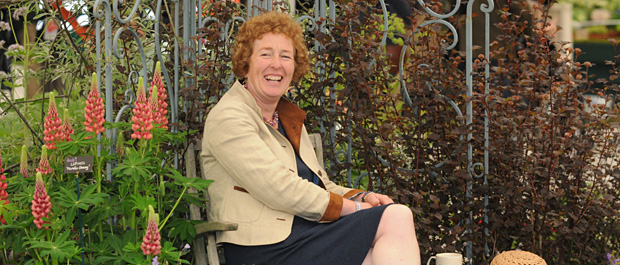
She said: “To be honest, I really don’t know how we managed to pull this off. Ten days ago I was sure that all we would have would be a green telly tubbyesque mound of green! But a little heat and a wee bit of sunshine coaxed the plants into opening and growing a little more. I also choose to show some very early spring plants that don’t normally get a look in at Chelsea as they are normally well over. Tired, emotional and delighted are my sentiments this morning and the bottom line is that without my husband Robert with whom I am celebrating 25 years next week, I could not have done this. My team also are unstoppable and I am so grateful to work with such professionals.”
Rosy also launched three new plants at the show: Gaillardia ‘Fanfare Blaze’, Nepeta Grandiflora ‘Summer Magic’ and Leucanthemum x Superbum ‘Real Neat’.
Show Gardens
Gardening duo Mark Straver and Robin Wallis from Hampshire based Hortus Loci were the main suppliers for four of the Show Gardens: The Brewin Dolphin Garden, the Royal Bank of Canada Blue Water Roof Garden, the The Arthritis Research UK Garden and the B&Q Sentebale ‘Forget-me-not’ Garden. Three of them were awarded Gold and the B&Q Sentebale ‘Forget-me-not’ Garden was awarded Silver-Gilt.
The Brewin Dolphin Garden, designed by Robert Myers created a calm, reflective and private garden space. With native planting, stone, timber and water, the garden gave an area for relaxation and informal entertainment.
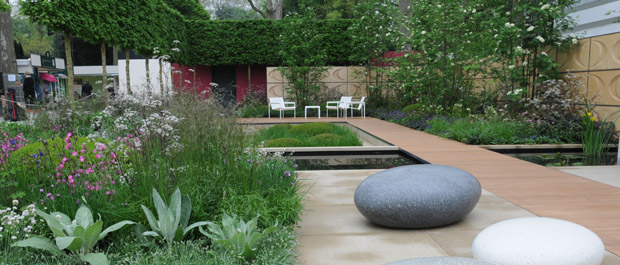
The planting was based on a palette of UK native species, reflecting interest in the benefits of native planting, as well as the sponsor’s British provenance as a UK company. Species were chosen for their flower colour, form and leaf texture, appropriate for this garden setting.
The selection of British natives was based on the Natural History Museum’s Checklist of British Native Plants and the planting will include some cultivars as well as the true native species.
Structure was created with pleached (woven) field maples enclosing the rear of the garden, and a scattering of multi-stemmed rowans creates vertical punctuation. Towards the rear of the garden, the planting has been selected for sun/semi-shade and will include the green textures of shrubs, grasses and herbaceous plants with splashes of white, purple and blue flowers. At the front of the garden, a mixture of grasses, shrubs and herbaceous plants contained pretty blue, pink and white flowers with splashes of yellow. In the central sunken area, the planting was predominantly green and textural, with low groundcovers around scattered domes of clipped box.
The garden promoted the use of UK native plants, and shows how they can be used within a garden setting and in an ornamental way. The use of native plants in gardening and landscape design is attracting growing interest in relation to their importance for creating local distinctiveness, sustainable planting and habitat for wildlife.
Timber was a theme within the garden, including areas of timber floor, a cantilevered canopy and a side wall with repeated oval relief. Several innovative sculptural pieces by sculptor Ben Barrell will also be incorporated.
Designed by Nigel Dunnett and The Landscape Agency, the RBC Blue Water Roof Garden explored the potential of ‘skyrise greening’ to bring trees, meadows and wetlands into the heart of the densest of cities for the benefit of urban dwellers.
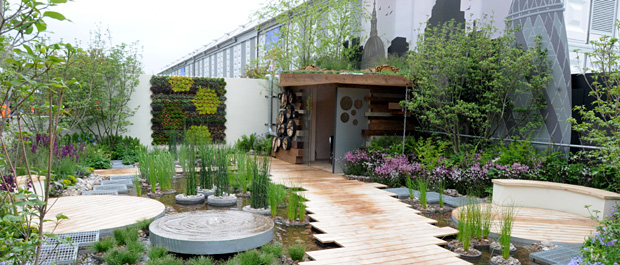
Almost every aspect of the design and the garden was about supporting wildlife and biodiversity. A central wetland area captures rainwater runoff, whilst a winding boardwalk leads to a dramatic building clad in habitat panels. Low-tech living walls that require no irrigation help to enclose the garden. The rooftop infrastructure of cooling vents and air-conditioning units are transformed into sculptural habitat features.
The whole garden was filled with flower-rich planting, divided into four main planting zones. A shade/woodland zone, based loosely on the ground flora of the woodlands of Eastern North America will include plants such as, Aquilegia canadensis, Trillium grandiflora, Mertensia virginica, Phlox divaricatus and Tiarella ‘Spring symphony’. A zone of sunny edges/green roof planting gave a mosaic of bright colours and grasses to create an urban sky meadow. Plants for free-draining soils in sun were used, such as Allium schoenoprasum, Dianthus carthusianorum, Erysimon ‘Bowles Mauve’, Festuca amythestina, and Salvia ‘Maynight’.
A wetland marginal zone contained a mass of blue Meconopsis with textural and foliage plants, such as Deschampsia flexuosa, Dryopteris lepidopoda, Hosta ‘Tom Schmid’ and Lychnis flos-cucuil.
An aquatic zone includes dramatic foliage plants emerged from the water, such as Cyperus eragrostis, Equisetum japonicum, Juncus effusus and Phragmites variegatus.
The Arthritis Research UK Garden was designed by Chris Beardshaw who last year scooped a gold medal for Furzey Gardens. It reflected the personal journey and emotions of someone with arthritis, from lack of understanding and confusion following a diagnosis, to a point where they are informed about the disease and are able to manage their pain.

The journey was represented across three key garden areas, beginning in the Veiled Garden.
This shaded, woodland garden featured a contemporary retreat and sculpture with a stepping stone pathway. A dense canopy of woodland trees is under-planted with plants and shrubs including Rosa glauca, Mertansia virginica, Trillium luteum, Digitalis purpurea ‘Snow Thimble’, Corydalis ‘Blackberry Wine’ and Brunnera ‘Jack Frost’.
The Lucid Garden with a white planted zone weaved itself under the woodland canopy. The white and green palette of plants is accented with the occasional sparkle of bright blue. Plants include Dianthus ‘Haytor White’, Anthyrium nipponicum pictum, Euphorbia ‘White Swan’ and Astrantia ‘White Giant’.
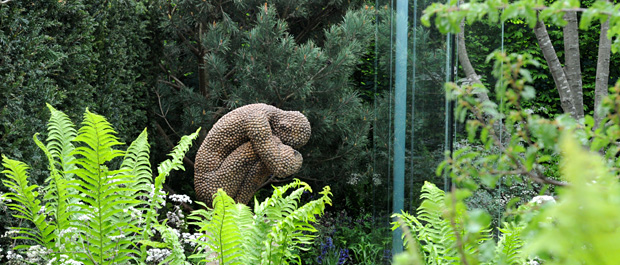
A reflective pool with a key sculpture helped give a sense of clarity before moving forwards into the slightly sunken Radiant Garden where there are warm, vibrant colours of pinks, purples, oranges and blues. Plants such as Iris ‘Supreme Sultan’, Lupinus ‘Masterpiece’, Lunaria’ Corfu Blue’, Tanacetum parthenium, Oenothera versicolor and Anchusa ‘Loddon Royalist’ provided a sense of warmth, openness and confidence as the person with arthritis learns to manage their condition and keep active, doing the things they love. The garden highlighted the journey that over 10 million people in the UK experience when faced with a diagnosis of arthritis to raise awareness of how Arthritis Research UK can help support people with arthritis to manage their condition through their information and funding of life-changing research.
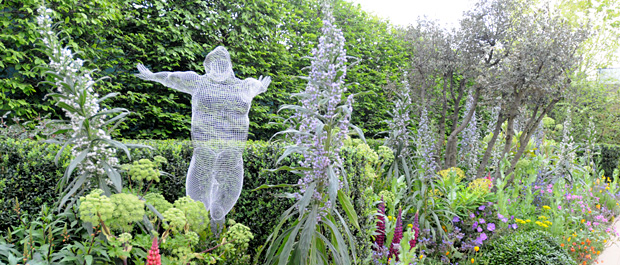
It was a big hit with the crowds and named the People’s Choice.
The B&Q Sentebale ‘Forget-me-not’ Garden was designed by Jinny Blom who was inspired by Prince Harry’s charity Sentebale, which means ‘Forget-Me-Not’ in Sesotho, the language spoken in Lesotho, Africa.
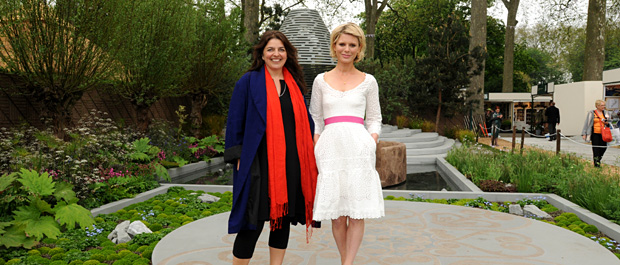
The pupose of the garden was to educate people about Lesotho’s ‘Forgotten Kingdom’ and more importantly, Sentebale’s role in supporting Lesotho’s most vulnerable children, many of whom are victims of extreme poverty and Lesotho’s HIV/AIDs epidemic.
It was a contemporary, conceptual evocation of the mountains, round houses and unusual blanket designs that are the national costume and it featured textural planting and muted colours to paint a picture, using plants compatible with the conditions in Lesotho.
The mountainous area of the garden were planted with pines, to mimic the scrubby evergreen foliage found clinging sparsely to the mountains of Lesotho, and the silvery foliage of Hippophae rhamnoides, which can cope with the very varied conditions and colonises rough land. It was under-planted with plants such as Acaena, Trifolium William, Silene fimbriata and Papaver glaucum.
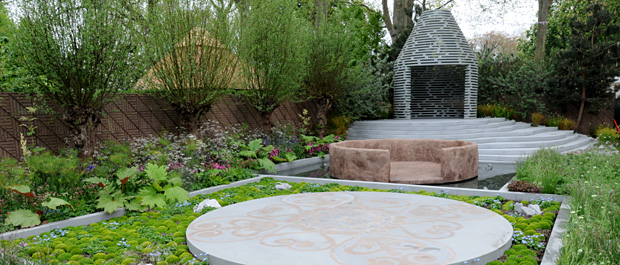
The semi-dry conditions at the foot of the mountain were represented by Acaena and Papaver glaucum as well as Salvia species, Nemesia varieties and Myosotis arvensis (forget-me-nots).
Below the mountain, there is a damp valley. In Lesotho, mass deforestation is being ameliorated by planting willow in the valley delta, so old Willow pollards will create a silvery screen in the garden, and accentuate the dampness. Amongst these were plants such as, Ajuga reptans, Anthriscus ‘Raven’s Wing’, Astrantia species, Darmera peltata, Rheum palmatum, silene dioica, Cyperus species, Osmunda regalis and Myosotis arvensis.
Hard-landscaping elements included a pavilion of laser-cut birch plywood, and rendered block work, hand painted with a Lesotho design.
Exbury Gardens on the edge of the New Forest supplied the Delancey East Village Garden with two rhododendrons. Michael Balston and Marie-Louise Agius created the garden to pick up the ‘designed for living’ theme of the Olympic legacy East Village, and represents the sustainable regeneration of a locality.
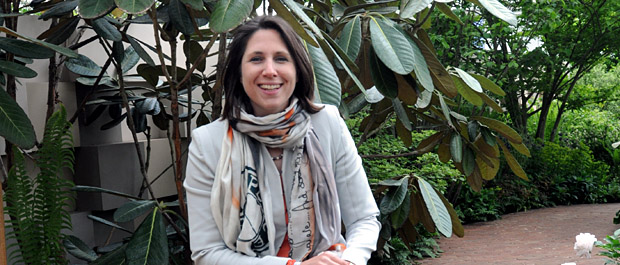
Marie-Louise explains why she included the Exbury rhododendrons in the design: “Exbury is home for me and was created by my great grandfather, Lionel de Rothschild, in the 20 years between 1920 – 1940. Having gone into landscape design as a career, my dream has always been to have a Chelsea Show Garden which I have now got and I was never going to come to Chelsea and not bring something up from Exbury. I’m so proud of it as my horticultural heritage.
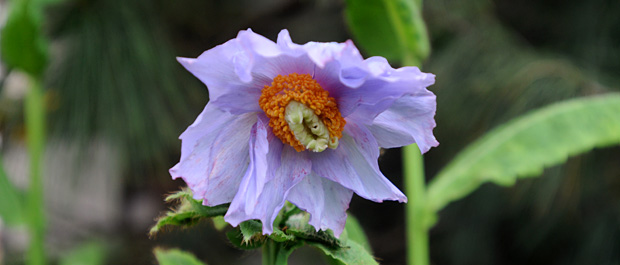
“We’ve tied it through Dr John Fothergill who was a great botanist and a physician practicing in Upton Park which is now West Ham Park which is in the heart of Stratford and Lee Valley which ties in with our sponsor Delancey. They’ve taken on the former athletes village down at the Olympic Park, now called East Village. It’s a new neighbourhood, E20, and so the fact that Dr John Fothergill lived in the area, we got a Fothergilla Major which is an acid woodland witch hazel plant which allowed us to link in with some more unusual acid loving plants.
“The Rhododendron macabeanum would work in a large urban courtyard environment and there are large communal courtyards at East Village. A plant like that wouldn’t be out of place and it’s a cracking plant for its foliage and the size of the leaves.They’ve had so many comments from people who have been looking and probably haven’t seen one this large at a garden in Chelsea.
“I don’t know anyone who has a back garden quite like Exbury to go and raid so I was incredibly privileged to be able to do that and incredibly proud at the same time.”
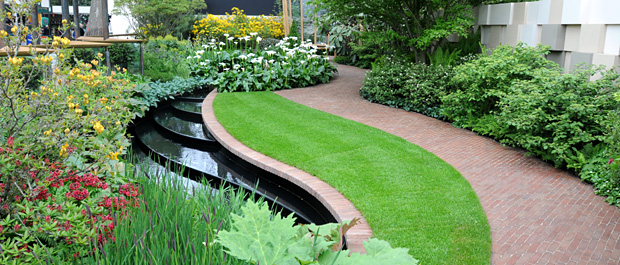
Referencing the local history of nurseries and gardens, it sets strong architecture against a rich horticultural palette, including less commonly exhibited shrubs and herbaceous plants.
Curving lines and leaf-forms responded to elements of the Olympic Park, and local references are picked up in the boundary, structures and planting. The balcony-like chevrons overlooking the garden evoke the ‘designed for living’ concept of the village with views onto green space.
The focus of the planting was on shrubs, textures and foliage, and this was realised through the use of plants such as rhododendrons, Enkianthus, Ceanothus, Pittosporum, Vibernum and ferns. These were off-set against an herbaceous palette.
Celebrating the creation and delivery of London’s ‘Legacy Promise’ and the birth of London’s newest neighbourhood, which opens to residents in late-Summer 2013, the garden was inspired by a desire to provide the best of city living, but with the luxury of open space.
The garden was awarded Gold.
Also on Main Avenue
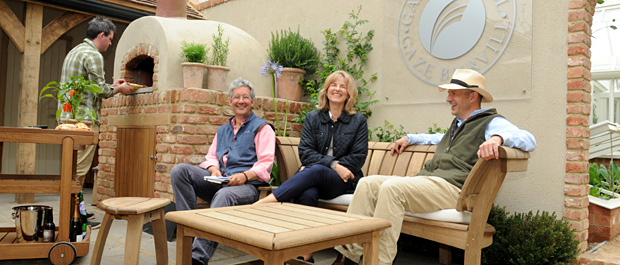
For the first time, Alitex (based in Petersfield) and Gaze Burvill (based in Alton) joined forces on Main Avenue. The two exhibits were linked by an arch, allowing movement from the outdoor oak furniture section to the bespoke greenhouses and conservatories section. A Jamie Oliver oven features in the Gaze Burvill side and Jamie was on hand himself on press day to bake herb bread.
Among the other celebrity visitors were model Jerry Hall and Countryfile presenter Tom Heap.
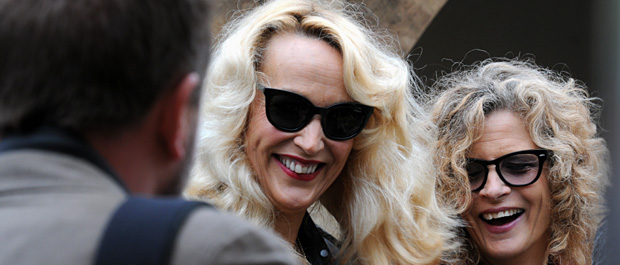
Also in the Great Pavillion
Lymington-based Heucheraholics showed 100 varieties of Heucheras, Heucherellas and Tiarella to celebrate 100 years of RHS Chelsea Flower Show
Also in the Great Pavillion were Waterlooville-based Ainsworth Displays (palm specialists) and Southampton-based Hampshire Carnivorous Plants – both awarded Gold.
Horticultural college Sparsholt exhibited with ‘Teavolution: the Evolution of Infusions’. Challenging the audience to reduce their environmental impact and increase their wellbeing by growing their own teas, the garden was based on the Mad Hatter’s Tea Party to reflect the effects that different types of tea have on people when drunk – the Mad Hatter is invigorating and stimulating like camellia-sinensis but the White Rabbit is calming like Rooibos.
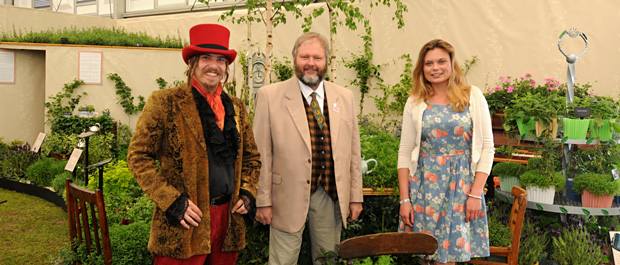
Displaying a wide range of plants that can be used for infusions, the garden was designed and created by a team of 8 Extended Diploma Horticulture students, led by lecturer Chris Bird who said: “This is the highlight of the year for our students who have used all the skills and experiences acquired during their course to design a garden worthy of exhibiting here.” They were awarded a Silver-Gilt Flora.
Running from Tuesday 21 to Saturday 25 May this year’s show offered visitors 15 spectacular Show Gardens, 11 Fresh Gardens – the best of contemporary garden design – and eight Artisan Gardens. In addition, 150 exhibits from nurseries and florists in the Great Pavilion and up to 250 trade stands meant the centenary RHS Chelsea Flower Show was one to remember.
Related:
Photos of 2013 RHS Chelsea Flower Show
Growing perfect plants for Chelsea Flower Show
Jinny Blom on the B&Q Sentebale Forget-me-not Garden
Hortus Loci En Route to Another Bumper Chelsea Flower Show Crop
Hardy’s Cottage Garden Plants to Celebrate 25 Years at Chelsea 2013
Hampshire nursery to launch new rosemary at Chelsea 2013